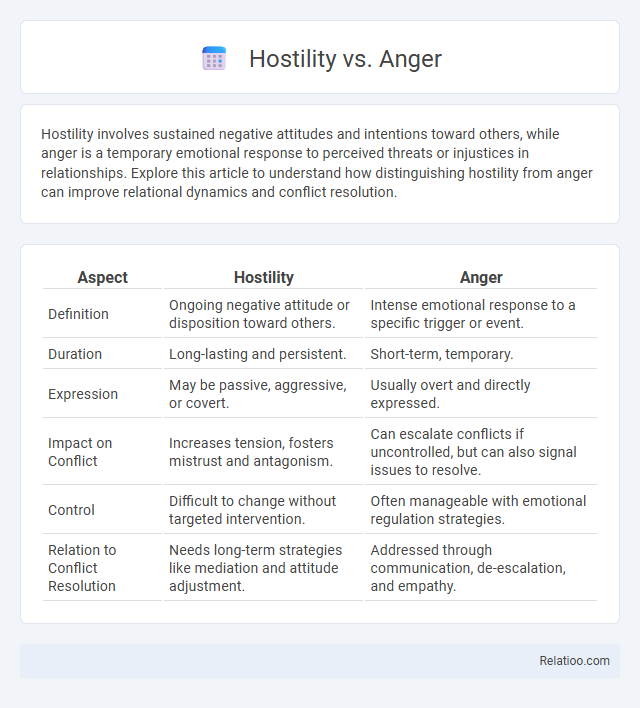Hostility involves sustained negative attitudes and intentions toward others, while anger is a temporary emotional response to perceived threats or injustices in relationships. Explore this article to understand how distinguishing hostility from anger can improve relational dynamics and conflict resolution.
Table of Comparison
| Aspect | Hostility | Anger |
|---|---|---|
| Definition | Ongoing negative attitude or disposition toward others. | Intense emotional response to a specific trigger or event. |
| Duration | Long-lasting and persistent. | Short-term, temporary. |
| Expression | May be passive, aggressive, or covert. | Usually overt and directly expressed. |
| Impact on Conflict | Increases tension, fosters mistrust and antagonism. | Can escalate conflicts if uncontrolled, but can also signal issues to resolve. |
| Control | Difficult to change without targeted intervention. | Often manageable with emotional regulation strategies. |
| Relation to Conflict Resolution | Needs long-term strategies like mediation and attitude adjustment. | Addressed through communication, de-escalation, and empathy. |
Understanding Hostility and Anger: Key Differences
Hostility and anger often intertwine but differ significantly in intensity and duration; anger is a natural emotional response to perceived threats or frustration, typically short-lived, whereas hostility represents a sustained attitude of opposition or animosity toward someone or something. Understanding these differences helps You manage your reactions effectively, as anger can escalate into hostility if unresolved, impacting relationships and mental health. Recognizing hostility as a persistent mindset rather than a fleeting emotion allows for better intervention strategies in conflict resolution and emotional regulation.
Psychological Roots of Hostility and Anger
Hostility originates from deep-seated psychological factors such as unresolved trauma, chronic stress, and perceived threats, often manifesting as a persistent pattern of negative attitudes toward others. Anger, by contrast, is an acute emotional response triggered by frustration, injustice, or perceived harm, typically serving as a signal for immediate reaction rather than long-term disposition. Understanding these distinctions aids in addressing underlying issues through targeted therapeutic interventions like cognitive-behavioral therapy, which focuses on recognizing and managing anger while reducing ingrained hostility.
How Hostility Manifests Compared to Anger
Hostility manifests through sustained negative attitudes and aggressive behaviors aimed at causing harm or asserting dominance, whereas anger is a transient emotional response to perceived threats or injustices. Unlike anger's immediate and often reactive nature, hostility involves a persistent mindset that influences long-term interpersonal interactions and decision-making. This enduring disposition in hostility often leads to chronic conflicts and social alienation, contrasting with anger's potential for quick resolution or de-escalation.
The Impact of Hostility on Relationships
Hostility in relationships often leads to sustained conflict, eroding trust and emotional connection more severely than transient anger or irritability. Unlike anger, which can be brief and situational, hostility represents a persistent negative attitude that undermines communication and increases stress between partners. Long-term hostility contributes to a toxic relational environment, heightening the risk of breakdowns and decreased overall relationship satisfaction.
Physiological Responses: Hostility vs Anger
Physiological responses to hostility often involve prolonged activation of the sympathetic nervous system, leading to increased heart rate, elevated blood pressure, and sustained muscle tension, which can contribute to chronic stress-related health issues. In contrast, anger triggers more acute and intense physiological changes such as a rapid spike in adrenaline and cortisol, resulting in a short-term fight-or-flight response characterized by heightened alertness and energy. Both hostility and anger impact the cardiovascular system but differ in duration and intensity, with hostility being more chronic and anger more episodic.
Short-Term and Long-Term Effects of Anger and Hostility
Anger typically triggers immediate physiological responses such as increased heart rate and elevated blood pressure, which can lead to short-term health risks like hypertension and weakened immune function. Hostility, characterized by a persistent negative attitude and mistrust toward others, contributes to long-term adverse effects including chronic stress, cardiovascular disease, and impaired social relationships. Sustained anger episodes escalate into hostility when unresolved, intensifying prolonged psychological strain and increasing susceptibility to conditions like coronary artery disease and depression.
Addressing Hostility in Conflict Resolution
Addressing hostility in conflict resolution requires recognizing underlying anger as a key emotional trigger that fuels aggressive behaviors and deteriorates communication. You can promote effective conflict resolution by employing active listening techniques and empathy to de-escalate hostility and foster mutual understanding. Implementing structured dialogue and conflict management strategies reduces tension and enables constructive problem-solving in hostile situations.
Healthy Ways to Manage Anger and Hostility
Managing anger and hostility effectively involves recognizing your emotional triggers and practicing techniques such as deep breathing, mindfulness, and cognitive reframing to reduce intense feelings. Developing healthy communication skills and engaging in physical activities can transform hostile energy into constructive outlets, preventing escalation and promoting emotional balance. Prioritizing self-awareness and seeking professional support when needed empowers you to maintain control over anger and hostility, fostering better relationships and personal well-being.
Hostility and Anger in the Workplace
Hostility in the workplace manifests as persistent negative attitudes and behaviors that create a toxic environment, often leading to decreased morale and productivity. Anger, while an intense emotional response, can be temporary and situational but may escalate into hostility if left unmanaged. Addressing anger through effective communication and conflict resolution strategies helps prevent the development of long-term hostility among employees.
Transforming Hostility and Anger into Positive Outcomes
Transforming hostility and anger into positive outcomes involves recognizing emotional triggers and channeling energy into constructive actions such as problem-solving or creative expression. Techniques like cognitive reframing, mindfulness, and empathy development reduce aggression and foster emotional resilience. Cultivating emotional intelligence enables individuals to convert negative feelings into motivation for personal growth and improved interpersonal relationships.

Infographic: Hostility vs Anger
 relatioo.com
relatioo.com